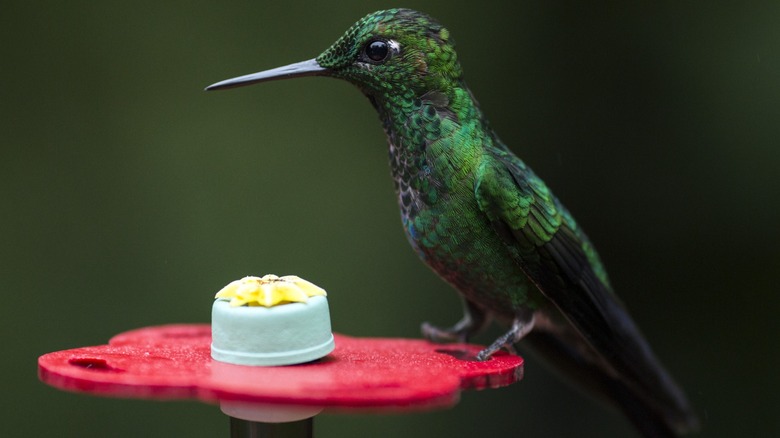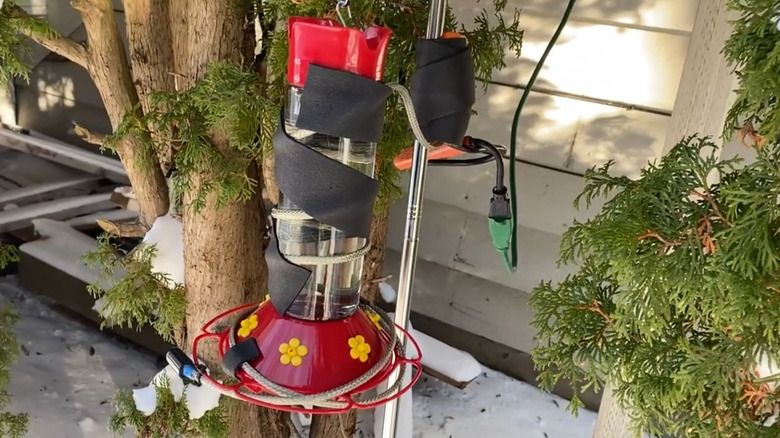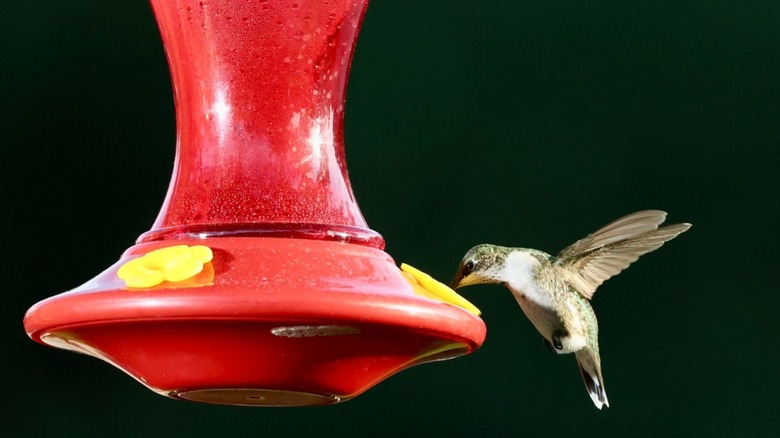The Popular Hummingbird Feeder Winter Warming Hack You May Want To Skip
There are plenty of tips and tricks for attracting hummingbirds to your yard during the winter. However, one of the biggest challenges is figuring out a way to keep the feeder from freezing. When temperatures drop, that sugar water quickly turns to ice, leaving your little visitors without a reliable food source. Some suggest heat tape — the same product used to prevent pipes from freezing – as a solution to wrap around your feeder. After all, heat tape is designed to help prevent ice buildup, it's relatively inexpensive, and it seems like a straightforward fix.
While heat tape can technically keep your hummingbird feeder warm, it comes with a few drawbacks that most people don't realize until it's too late. You might be surprised by how much energy they draw, how they complicate refilling, and the potential fire hazards they pose — not to mention the unintended harm to the very birds you're trying to help.
When you factor in how much of a hassle maintenance is and the fact that there are better alternatives available, heat tape starts looking less like a smart solution and more like a shortcut that creates more problems than it solves. Luckily, there are safer alternatives available. So, before you head to the hardware store to pick up a roll of heat tape for your feeder, you should know exactly why this popular hack isn't as practical, or as safe, as it might seem.
The problem with heat tape
As effective as heat tapes can be, you have to be very careful how you apply them — even on PVC pipes. Whether your hummingbird feeder is glass or plastic, if the tape is not applied properly, it can create hot spots that reach dangerously high temperatures, potentially melting, cracking, or even igniting the feeder. Once heat tape is wrapped around your feeder, cleaning and refilling become harder. You'll need to either unwrap and rewrap the tape each time you change the nectar or awkwardly work around it. The added weight of the tape also makes the feeder heavier and can cause it to tilt or hang unevenly. Even if you solve that issue, the energy cost is another concern.
Some heat tapes run continuously when plugged in, meaning you're heating a feeder 24/7 throughout winter. Even if you don't mind the added cost, you can't ignore what happens to the nectar itself. Heat tape often causes uneven warming, meaning parts of your feeder might get scalding hot. And if the nectar's too warm, it could injure the birds. The constant heating also encourages bacterial growth and causes the sugar water to ferment faster, which means you'll need to clean and refill the feeder a lot more frequently.
Alternatives you should consider instead
There are safer and more effective ways to keep your hummingbird feeder functional through winter. The simplest one is to bring your feeder inside at night when temperatures drop to their lowest, then put it back out first thing in the morning. Hummingbirds typically feed most actively at dawn and dusk, so you'll catch their peak feeding times while avoiding the frozen overnight hours. It costs nothing but does require consistency to maintain the routine.
If you'd rather keep a feeder outside continuously, consider investing in a heated hummingbird feeder. Some feeders have built-in heating elements that are thermostatically controlled, meaning they only activate when temperatures approach freezing levels. They're engineered to distribute heat evenly without creating dangerous hot spots, and they use significantly less energy than heat tape because they're not running constantly. If you search online, you'll find models ranging anywhere from $25 to $200, which might seem steep compared to a $15 roll of heat tape, but they're built specifically for the job, tougher than most people think, and far safer.
Another option is to set up multiple feeders and rotate them. Keep one inside as a backup, and when the outdoor feeder starts to freeze, swap them out. The frozen one thaws indoors while the fresh one serves the birds. It's more work, but it costs nothing beyond the price of an extra feeder. Ultimately, consider the safety of both the birds and your home before reaching for heat tape


